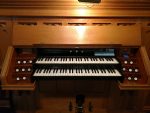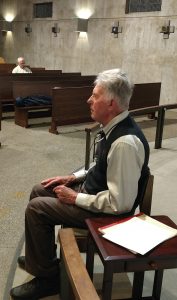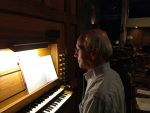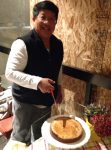
Vashon Island lies at the end of a short ferry ride from both Tacoma and Seattle. It has been the home to a number of artists, musicians, and writers–and is also the home of three organs visited by the Tacoma Chapter of the AGO on Saturday, October 13.
Holy Spirit Episcopal Church

Carl Kishline and Tim Drewes served as hosts for this program, which began at the Holy Spirit Episcopal Church. Tim Drewes gave a brief history of the organ, which was built by A.B. Felgemaker for Westwood Baptist Church of Cincinnati, as Opus 629 (or thereabouts) in 1896. Exactly 85 years after its dedication, it was removed and sold through the Organ Clearing House. The organ was installed at Holy Spirit by Randy McCarty, a harpsichordist at Pacific Lutheran University who was responsible for the acquisition of 8 to 10 additional organs transplanted to the Pacific Northwest through Organ Clearing House at about the same time. The organ is in much the same condition as when it was installed, the biggest change being a transposition of the Great 4-foot flute to a 2-foot flute by Tim Drewes.

Following the introduction, Tim demonstrated various sounds of the organ, including strings, flutes, and the principal chorus, based on an 8-foot open diapason. The Swell division has a 16-foot flute, which is a strong stop for accompanying hymns.. Tim played Bach’s F Major Prelude and Fugue from the Eight Little Preludes and Fugues, leading to some open bench time.
Vashon Presbyterian Church

The Estey organ at Vashon Presbyterian Church is most likely opus 23, made in 1902 for a merchant in Philadelphia. Its subsequent history is somewhat vague, but it most likely made its way to a Portland funeral home, followed by at least one additional funeral home. Vashon Presbyterian acquired the organ from a funeral home in Walla Walla in 1999. The organ features three stops on each keyboard and a beautiful oak case in pristine condition. Tim Drewes pointed out that the case might not be in such good shape had the organ been in a church surrounded by kids for the many years it sat in funeral homes.
At one time, the organ had a player mechanism which was removed and has been lost. The church still has some of the player rolls.

The organ also has an unusual stop arrangement whereby there is a small “keyboard” sitting above the other two, each key labeled with the name of a stop. The stop is engaged by pressing the white note, then disengaged by pressing the black note above it.
Vashon Lutheran Church

Following the Presbyterian Church, the last featured church was Vashon Lutheran, which features a three-rank Moller Artiste. The stop list shows quite a few stops, but all are based on the three ranks. There are no couplers, but most of the stops show up in some way on both keyboards and the pedal, with different names, and different pitches.

Much of the history of this Moller Artiste is unknown, but Vashon Lutheran acquired it from Anacortes Lutheran in 1969. Members of the church traveled to Anacortes with a truck and brought the organ back on the ferry.
Carl Kishline prepared a handout for this meeting, reproduced below. Tim Drewes also provided a copy of the dedication program from the Holy Spirit Episcopal Church, also reproduced below. Each of these documents contains multiple pages. To page through the document, select it and use the controls at the bottom.
Thanks to Carl Kishline for organizing this program, and to Tim Drewes for his expertise in the organs.
20181013-Holy Spirir-Inaugural Recital












